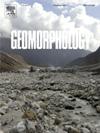Using Google Earth Engine to assess cumulative impacts of cascade dams on river surface morphology in mountainous watersheds- Case of the lower Yalong River
IF 3.1
2区 地球科学
Q2 GEOGRAPHY, PHYSICAL
引用次数: 0
Abstract
Cascade dam construction significantly alters river surface morphology, posing challenges for sustainable river management. This study investigates the cumulative morphological impacts and restoration potential in the lower Yalong River using topographic maps, satellite imagery, and field surveys. In contrast to previous research focused on local hydrodynamics or sediment processes, this work emphasizes large-scale, long-term river surface evolution. Five key morphological indicators—river width, width ratio, shape index, sinuosity index, and stability—were extracted from multi-temporal Landsat imagery using the Modified Normalized Difference Water Index (MNDWI). A dynamic rate method was used to quantify the average annual change of each indicator during different dam construction stages. The results show that cascade dams substantially reshaped water surface patterns: 67 % of river segments widened upstream to form reservoirs, while 6 % experienced downstream narrowing due to flow reduction. Pre-dam morphological changes extended up to 134 km, while post-dam impacts were limited to within 15 km. The most significant changes occurred during the construction of the first and fourth dams, while the fifth dam had minimal influence due to its smaller scale. Correlation and principal component analyses identified river width and stability as the most sensitive indicators of cumulative impacts. These findings demonstrate that cascade dams induce pronounced and phase-specific alterations to river morphology, with both localized and far-reaching upstream-downstream interactions. The study improves understanding of geomorphic responses to multi-dam systems and offers a quantitative basis for evaluating ecological resilience and guiding sustainable river basin management in mountainous regions.
利用谷歌Earth Engine评估山地流域梯级坝对河面形态的累积影响——以雅砻江下游为例
梯级水坝的建设显著地改变了河流的表面形态,对河流的可持续管理提出了挑战。利用地形图、卫星影像和野外调查等方法,研究了雅砻江下游的累积形态影响及其恢复潜力。与以往的研究侧重于局部水动力或泥沙过程相反,这项工作强调大规模、长期的河流表面演变。利用修正归一化差水指数(MNDWI)从多时相Landsat图像中提取了河流宽度、宽度比、形状指数、弯曲指数和稳定性这5个关键形态指标。采用动态速率法量化各指标在大坝建设不同阶段的年平均变化。结果表明,梯级坝极大地改变了水面格局:67%的河段上游变宽形成水库,而6%的河段下游因流量减少而变窄。坝前形态变化扩展至134 km,而坝后影响限制在15 km以内。最显著的变化发生在第一和第四大坝的建设期间,而第五大坝由于其规模较小,影响最小。相关分析和主成分分析表明,河流宽度和稳定性是累积影响最敏感的指标。这些研究结果表明,梯级水坝引起了河流形态的明显和阶段性变化,具有局部和深远的上下游相互作用。该研究提高了对多坝系统地貌响应的认识,为山区生态恢复力评价和指导流域可持续管理提供了定量依据。
本文章由计算机程序翻译,如有差异,请以英文原文为准。
求助全文
约1分钟内获得全文
求助全文
来源期刊

Geomorphology
地学-地球科学综合
CiteScore
8.00
自引率
10.30%
发文量
309
审稿时长
3.4 months
期刊介绍:
Our journal''s scope includes geomorphic themes of: tectonics and regional structure; glacial processes and landforms; fluvial sequences, Quaternary environmental change and dating; fluvial processes and landforms; mass movement, slopes and periglacial processes; hillslopes and soil erosion; weathering, karst and soils; aeolian processes and landforms, coastal dunes and arid environments; coastal and marine processes, estuaries and lakes; modelling, theoretical and quantitative geomorphology; DEM, GIS and remote sensing methods and applications; hazards, applied and planetary geomorphology; and volcanics.
 求助内容:
求助内容: 应助结果提醒方式:
应助结果提醒方式:


